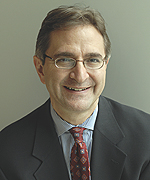Chicago In the News
The Chronicle’s biweekly column Chicago In the News offers a digest of commentary and quotations by a few of the University faculty members, students and alumni who have been headlining the news in recent weeks. Chicago faculty members are some of the most frequently quoted experts, so space allows publishing references to only selected examples. To read many of the full newspaper articles mentioned in this column, visit the University News Office Web site: http://news.uchicago.edu.
Big-city hurdles for small business
Beth Milnikel, Director of the Institute for Justice Clinic on Entrepreneurship, based at the Law School, was a guest Tuesday, May 12 on WBEZ Radio’s program “848.” Amid a recent report by the Institute for Justice about small businesses, Milnikel spoke about the difficulties of entrepreneurship in Chicago: “We understand that the legislature does need to pass laws to protect the health and safety of people in Chicago. But in this report, we found law after law that does nothing of the sort. We don’t even know why some of these laws are on the books. They seem to do nothing but keep small businesses out of work.” Milnikel said the phenomenon is widespread across the country but claimed in Chicago, one would need to “get in with the aldermen to get anything done.” “If you’re the kind of person that might be the first in your family to be in Chicago or start a business, if you don’t come from a moneyed or connected background, it becomes a lot more difficult to start a business. But in today’s economy, those are the people we need to have the freedom to get something started and do something new.”
 Steven Kaplan |
|
Deal making a good economic sign
Steven Kaplan, the Neubauer Family Professor of Entrepreneurship and Finance at Chicago Booth, was quoted in a Monday, May 4 article in Newsweek about the recent uptick in large mergers and acquisitions in the financial markets. From Oracle to PepsiCo to GlaxoSmithKline, today’s deals seem more defensive, the article stated, although analysts view the acquisitions as a reflection of optimism in the market. In the fourth quarter of 2008, U.S. deals announced were the lowest since late 2003, and 75 percent off the highest figures in mid-2007, according to Thomson Reuters. “The activity is very positive,” Kaplan said. “More deals means we are no longer falling.”
Economic ‘spring thaw’
Anil Kashyap, the Edward Eagle Brown Professor of Economics and Finance at Chicago Booth, was quoted in a Thursday, May 21 article in the Washington Post about the economy. The article noted that a “spring thaw” of the economy has occurred, even though President Obama’s major rescue programs have yet to kick in fully—the Federal Reserve has released less than one-fiftieth of its $1 trillion program to support consumer and small-business lending. Nonetheless, confidence has deepened in financial markets, as reflected in the 34 percent jump in the Standard & Poor’s 500 stock index and major banks’ abilities to raise billions in private capital. But analysts warn that although the economy could pull out of the recession later this year, unemployment could stay high through 2011 while consumer spending is still curtailed. “The feeling is that for now we’ve avoided the Great Depression,” Kashyap said. “But the real economy is still in pretty bad shape.”
Study ties biology of tumor to mood
A Wednesday, May 20 article in Health Day detailed a University study in Psychology that found a biological link between cancer-causing tumors and negative moods. The study is the first to show that properties of a cancerous tumor can cause depression, as do emotional distress from a diagnosis and the side effects of chemotherapy. The findings are detailed in the Monday, May 18 issue of the Proceedings of the National Academy of Sciences. In the study, researchers put rats through a series of exercises and found that rats with tumors were less motivated to swim and less eager to drink sugar water, both activities they normally enjoy. “In this case, examining behavioral responses to tumors in non-human animals is particularly useful, because the rats have no awareness of the disease, and thus their behavioral changes were likely the result of purely biological factors,” said senior study author Brian Prendergast, Associate Professor in Psychology and the College. Leah Pyter, a postdoctoral fellow, also was quoted in the story. Science, the Daily Telegraph and BBC also reported the study’s findings.
Truckers plugged into conservation
Argonne National Laboratory’s research into idling, long haul trucks and their effects on the environment and business were featured in a Wednesday, May 20 article in The New York Times. Many drivers sleep in their rigs, a practice, which along with workday idling, uses more than 2 billion gallons of diesel fuel annually. The industry is now researching alternatives, including “electrified” parking spaces, which would provide plugged-in truckers with heat, air conditioning, electricity and even Internet or TV access. The forms include single-system electrification, which consists of a $10 plastic window adapter, or a $2,500 shore-based power supply. Auxiliary power units or detached heating and cooling units also are options. The article quoted Argonne Systems Analyst Linda Gaines and Senior Project Manager Terry Levinson.
Source or symptom?
Omar McRoberts, Associate Professor in Sociology and the College, spoke about storefront churches in the North Lawndale neighborhood in a Sunday, May 17 article in the Chicago Tribune. Storefront churches, the article stated, date to the Great Migration of African Americans from the South to the North, when newcomers could only afford small worship spaces to congregate. There are nearly 200 churches in the North Lawndale area, mainly storefronts, and the debate is whether having non-profit, tax-exempt entities on commercial land is causing more “economic harm than spiritual good.” Said McRoberts, “Churches are not really blocking development. They’re a symptom of the lack of development. Now the question that comes up … is what are these institutions doing to help turn these neighborhoods around?”
![[Chronicle]](/images/sidebar_header_oct06.gif)